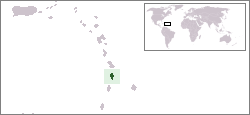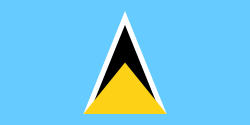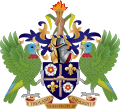Outline of Saint Lucia
 From Wikipedia - Reading time: 10 min
From Wikipedia - Reading time: 10 min


The following outline is provided as an overview of and topical guide to Saint Lucia:
Saint Lucia is a sovereign island nation located in the Lesser Antilles archipelago in the eastern Caribbean Sea adjacent to the North Atlantic Ocean.[1] Saint Lucia is located north of the islands of Saint Vincent and the Grenadines, northwest of Barbados and south of Martinique. It is also known as the "Helen of the West Indies" because it switched between British and French control so often it was likened to the mythical Helen of Troy.
Saint Lucia is one of the Windward Islands, named for Saint Lucy of Syracuse. It was first visited by Europeans in about the year 1500 and first colonized successfully by France who signed a treaty with the native Carib peoples in 1660. Great Britain took control of the island from 1663 to 1667 then went to war with France over it fourteen times, and finally took complete control in 1814. Representative government came about in 1924 (with universal adult suffrage from 1953) and from 1958 to 1962 the island was a member of the Federation of the West Indies. Finally, on February 22, 1979, Saint Lucia became an independent state of the Commonwealth of Nations. The island nation celebrates this every year with a public holiday.
General reference
[edit]
- Pronunciation:
- Common English country name: Saint Lucia
- Official English country name: Saint Lucia
- Common endonym(s):
- Official endonym(s):
- Adjectival(s):
- Demonym(s):
- Etymology: Name of Saint Lucia
- ISO country codes: LC, LCA, 662
- ISO region codes: See ISO 3166-2:LC
- Internet country code top-level domain: .lc
Geography of Saint Lucia
[edit]- Saint Lucia is...
- Location:
- Northern Hemisphere and Western Hemisphere
- North America (though not on the mainland)
- Atlantic Ocean
- Time zone: Eastern Caribbean Time (UTC-04)
- Extreme points of Saint Lucia
- High: Mount Gimie 950 m (3,117 ft)
- Low: Caribbean Sea 0 m
- Land boundaries: none
- Coastline: 158 km
- Northern Hemisphere and Western Hemisphere
- Population of Saint Lucia: 165,000 - 180th most populous country
- Area of Saint Lucia: 620 km2
- Atlas of Saint Lucia
Environment of Saint Lucia
[edit]- Climate of Saint Lucia
- Renewable energy in Saint Lucia
- Geology of Saint Lucia
- Protected areas of Saint Lucia
- Wildlife of Saint Lucia
Natural geographic features of Saint Lucia
[edit]- Fjords of Saint Lucia
- Glaciers of Saint Lucia
- Islands of Saint Lucia
- Lakes of Saint Lucia
- Mountains of Saint Lucia
- Rivers of Saint Lucia
- Valleys of Saint Lucia
- World Heritage Sites in Saint Lucia
Regions of Saint Lucia
[edit]Districts of Saint Lucia (first order)
Ecoregions of Saint Lucia
[edit]List of ecoregions in Saint Lucia
Demography of Saint Lucia
[edit]Government and politics of Saint Lucia
[edit]- Form of government:
- Capital of Saint Lucia: Castries
- Elections in Saint Lucia
- Political parties in Saint Lucia
Branches of the government of Saint Lucia
[edit]Executive branch of the government of Saint Lucia
[edit]- Head of state: Monarch of Saint Lucia,
- Head of government: Prime Minister of Saint Lucia,
- Cabinet of Saint Lucia
Legislative branch of the government of Saint Lucia
[edit]Judicial branch of the government of Saint Lucia
[edit]Foreign relations of Saint Lucia
[edit]Foreign relations of Saint Lucia
International organization membership
[edit]Saint Lucia is a member of:[1]
Law and order in Saint Lucia
[edit]- Constitution of Saint Lucia
- Crime in Saint Lucia
- Human rights in Saint Lucia
- Law enforcement in Saint Lucia
Military of Saint Lucia
[edit]- Command
- Forces
- Military history of Saint Lucia
- Military ranks of Saint Lucia
Local government in Saint Lucia
[edit]Local government in Saint Lucia
History of Saint Lucia
[edit]- Timeline of the history of Saint Lucia
- Current events of Saint Lucia
- Military history of Saint Lucia
Culture of Saint Lucia
[edit]- Architecture of Saint Lucia
- Cuisine of Saint Lucia
- Festivals in Saint Lucia
- Languages of Saint Lucia
- Media in Saint Lucia
- National symbols of Saint Lucia
- People of Saint Lucia
- Public holidays in Saint Lucia
- Records of Saint Lucia
- Religion in Saint Lucia
- World Heritage Sites in Saint Lucia
Art in Saint Lucia
[edit]- Art in Saint Lucia
- Cinema of Saint Lucia
- Literature of Saint Lucia
- Music of Saint Lucia
- Television in Saint Lucia
- Theatre in Saint Lucia
Sports in Saint Lucia
[edit]Economy and infrastructure of Saint Lucia
[edit]- Economic rank, by nominal GDP (2007): 169th (one hundred and sixty ninth)
- Agriculture in Saint Lucia
- Banking in Saint Lucia
- Communications in Saint Lucia
- Companies of Saint Lucia
- Currency of Saint Lucia: Dollar
- Energy in Saint Lucia
- Mining in Saint Lucia
- Tourism in Saint Lucia
- Transport in Saint Lucia
- Saint Lucia Stock Exchange
Education in Saint Lucia
[edit]Infrastructure of Saint Lucia
[edit]See also
[edit]- Index of Saint Lucia-related articles
- List of international rankings
- List of Saint Lucia-related topics
- Member state of the Commonwealth of Nations
- Member state of the United Nations
- Monarchy of Saint Lucia
- Outline of geography
- Outline of North America
- Outline of the Caribbean
References
[edit]- ^ a b "Saint Lucia". The World Factbook. United States Central Intelligence Agency. July 7, 2009. Retrieved July 23, 2009.
External links
[edit]![]() Wikimedia Atlas of Saint Lucia
Wikimedia Atlas of Saint Lucia
- Official website of the Government of Saint Lucia
- "Compendium of Environmental Statistics" (PDF). Archived from the original (PDF) on 2009-11-13. Retrieved 2008-10-26. (3.95 MiB)
- "2001 Population and Housing Census Report" (PDF). Archived from the original (PDF) on 2008-02-16. (10.1 MiB)
- Official website of the Saint Lucia Solid Waste Management Authority
- Official website of Saint Lucia Meteorological Services
- Portal of the Saint Lucia Tourism Authority
- Saint Lucia - Simply Beautiful
- St. Lucia Pictures
- Pictures & Images of St. Lucia Archived 2005-02-04 at the Wayback Machine
- Teaching Resources on St Lucia
- The Technical Analysis Society of St. Lucia
- Map of St. Lucia
- Photos, videos, and travelogue from St. Lucia
 KSF
KSF
